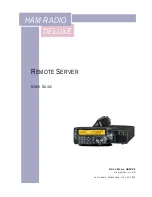
Troubleshooting
Server Mode
In Server mode, the EtherPath runs under the TCP/IP network protocol. It will listen on a configured port
number. The server will wait for connection after initialization.
After a connection is established, the server always keeps checking for data on both Ethernet and Serial
Ports.
If data from the Ethernet network is received, it will first check for a special control symbol, filter it if found
and then send the rest of the data to the serial port.
If data from the serial port is received, it will read the data from the serial buffer, move the data into the
network buffer and send it by Ethernet to the application when the buffer is full or on the next tick of the
transmit timer.
Transmit Conditions
The EtherPath will transmit an Ethernet packet when any of these conditions are met:
•
Transmit Timer is up and running in
Transmit Timer Mode
•
Idle Timer is up and running in
Idle Timeout Mode
.
•
Transmit Buffer full
•
LT Character is encountered and
Transmit on Line Terminator
Function is ON ( Client Only )
Locking Avoidance Mechanism
When two EtherPaths are used to emulate a direct serial connection over the network as described
previously, the ‘Server Mode’ EtherPath could be locked if its connecting ‘Client Mode’ EtherPath
disconnects abnormally. If this situation happens, no connection to the ‘Server Mode’ EtherPath is possible,
and it should be reset. To solve this problem, the following system is used.
When in Telnet Server mode:
a telnet NOP command is used as a heatbeat keep-alive signal. A fixed
keep-alive time of 60 seconds is used.
When in Raw Server mode:
7. A "Keep-Alive" message is defined as a 21-byte string:
sErIaLsErVeRkEePaLiVe
8. This string “sErIaLsErVeRkEePaLiVe” is sent out by the ‘
Client
Mode’ EtherPath if the time since the
previous transmission exceeds
the configured keep-alive time.
It tells the ‘Server Mode’ EtherPath
that ‘I am still alive and do not close the connection’. It keeps sending out this string every keep-alive
time seconds if there is no data to send.
9. The ‘
Server
Mode’ EtherPath will disconnect the link if it does not receive any packet from the ‘Client
Mode’ EtherPath within a period of three times the keep-alive time.
10. The ‘Server Mode’ EtherPath will then initialize and accept a new connection. The ‘Client Mode’
EtherPath will attempt to reconnect as soon as a network path becomes available.
11. User-written programs can avoid this operation by setting the keep-alive time to zero. If a user-written
program uses the EtherPath keep-alive, the program must handle the keep-alive packet properly.
49




































